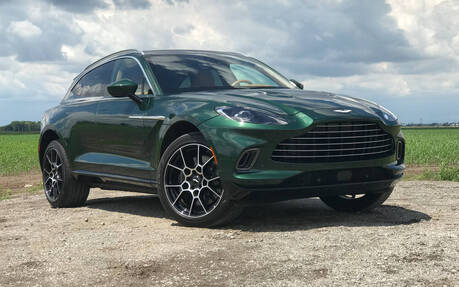2021 Aston Martin DBX: The SUV Prince
The Aston Martin DBX, the British automaker’s first-ever SUV, is not the fastest or the most powerful out there. It’s also not the most luxurious or the most expensive. As for technology and equipment, it trails competitors in those departments, as well.
However, one look at its exquisite silhouette is enough to realize it’s the most elegant of all. Go ahead and feast your eyes on the long and swooping body mixing aluminum and composite materials in a delightful combination of powerful and delicate lines.
- Also: Aston Martin Announces Changes for 2022… and 2025
- Also: Aston Martin DBX Adds to the Growing List of High-end Luxury SUVs
The large, oblong headlights and stately front grille with thin chrome slats make it absolutely clear that the DBX is a member of the century-old Aston Martin family. In the rear, the wave-shaped, upswept spoiler is reminiscent of the spirited Vantage’s. The streamlined profile sitting on 22-inch alloys creates the illusion that the DBX is relatively compact, but in reality it’s longer than a Range Rover.

Solid and Surprisingly Light
The Aston Martin DBX is built on a more exotic architecture than most if not all rivals. Utilizing bonded aluminium, a construction method the company has refined through the development of its sports cars such as the DBS Superleggera, the body structure is both very light and incredibly stiff. With a curb weight of 2,245 kilograms, it’s one of the lightest SUVs in its class.
The exceptionally rigid body allowed engineers to use softer bushings and mounts for the double-wishbone front and multi-link rear suspension. They also incorporated the latest 48V electric anti-roll control system (eARC) and electronic adaptive dampers to provide the DBX with a huge breadth of ability.
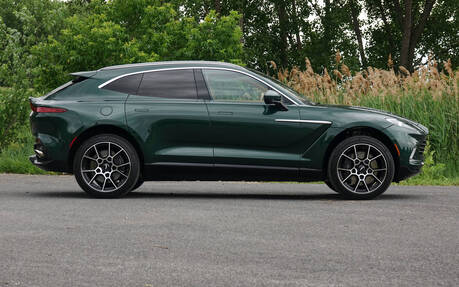
The adaptive triple-chamber air suspension has the ability to increase the ride height by 45 millimetres for improved approach, breakover and departure angles or lower it by 50 millimetres for easier access, reduced drag and better handling resulting from a lower centre of gravity.
In the Thick of the Race
Under the broad hood are front strut towers connected by huge aluminum braces for increased rigidity and precision. These superb components surround the twin-turbocharged 4.0-litre V8 engine that the DBX shares with the DB11 and Vantage coupes. Built by AMG in Germany and tailored by Aston Martin at the brand new St. Athan plant in Wales, it delivers 542 horsepower along with 516 pound-feet of torque.
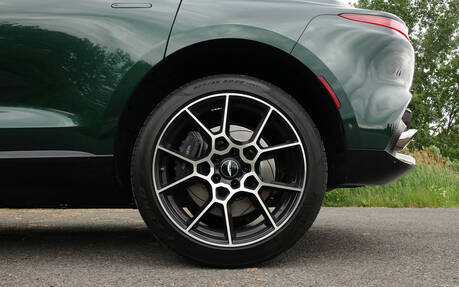
Power is transferred to all four wheels through a nine-speed automatic transmission, carbon fibre driveshaft and sophisticated AWD system that can send up to 100 percent of the engine’s torque to the rear axle when necessary. An electronic locking differential then splits torque between the two rear wheels. There are six drive modes to choose from, two of which are off-road oriented. Selection is done via a rotary dial on the steering wheel.
We clocked Aston Martin’s first SUV—and AWD-equipped vehicle—at 5.02 seconds in 0-100 km/h sprints and 3.15 seconds in 80-120 km/h manoeuvres. The quarter-mile run was achieved in 13.22 seconds at 180.1 km/h. In order to catch up with rivals, including its AMG cousins, the DBX would need more power and a launch control function. Hopefully that will come with an S variant as early as next year.
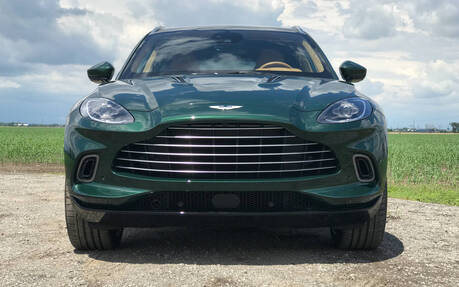
As for braking performance, the DBX stopped from 100-0 km/h over a distance of 35.7 metres thanks to a combination of 410-mm front discs and 390-mm rear discs—impressive considering the vehicle’s size.
From Tradition to Exception
In true Aston Martin fashion, the interior of the DBX is draped in thick, finely sewn leather. The front buckets, also shared with the DB11, are comfortable and nicely sculpted, contributing to a proper driving position. Visibility is impeccable over 180 degrees, but becomes more of a challenge in the rear due to the wide D-pillars and tall beltline. The rear outboard seats are pretty decent, while the cargo area (covered in thick carpeting) is easy to expand with the 40/20/40-split seatbacks.
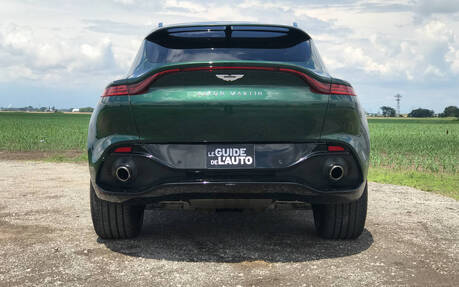
The design of the dashboard, steering wheel and controls is classic Aston Martin. On the 12.3-inch digital instrument panel facing the driver are circular instruments with a multi-function display nestled in between. The rings around the speedometer and tachometer appropriately turn red when Sport+ mode is activated.
The 10.5-inch interface on the centre stack is not a touchscreen, sadly. It’s an old Mercedes-Benz unit that drivers can play with using a rotary controller and two buttons on the centre console. Given the price of the DBX, this has to change soon. We also didn’t like the transmission buttons positioned right above—they are hard to reach and not so convenient. The large aluminum paddle shifters on the steering wheel are a joy to use, however.
In GT mode, the DBX proves flexible and agile for such a bulky and hefty vehicle. Steering is precise and highly responsive. Switching to Sport mode cranks things up a notch. And when you get the opportunity to engage Sport+, say on a track or a quiet, turn-filled country road, the suspension firms up even more, steering and throttle response becomes super-sharp, stability control is turned off and the exhaust system is completely freed. Sinking its big claws into the pavement, the DBX attacks corners with no body roll whatsoever, then slightly oversteers past the apex when you hit the throttle again, filling your ears with the throaty roar of the AMG V8.
Our Verdict
You only need one finger—okay, maybe two—to count the number of SUVs that can match the Aston Martin DBX in terms of handling. Chief engineer Matt Becker, who joined the brand after nearly three decades of working his magic at Lotus, took five full years to develop and perfect the DBX with the help of his team. Now with former AMG boss Tobias Moers at the helm, what comes next will be even better.
| Test drive report | |
| Test model | 2021 Aston Martin DBX |
|---|---|
| Trim level | V8 |
| Price range | 238 680 $ |
| Price as tested | 238 680 $ |
| Warranty (basic) | 3 years/unlimited |
| Warranty (powertrain) | 3 years/unlimited |
| Fuel economy (city/highway/observed) | 17,1 / 12,8 / N/A L/100km |
| Options | Buckinghamshire Green paint ($7,300), DB Elegance package ($5,500), Luxury Package ($3,700), wood-trimmed console and doors ($3,200), sport exhaust ($2,800), Alcantara headliner ($2,800), dark Ziricote open-pore wood ($1,900) |
| Competitive models | 2021 Porsche Cayenne, 2021 Audi Q8, 2021 Maserati Levante |
| Strong points |
|
| Weak points |
|
| Editor's rating | |
| Fuel economy | The ratings reflect the vehicle’s size and the engine’s performance. |
| Comfort | The ride is not too stiff and fairly quiet, while the seats are nicely sculpted. |
| Performance | The twin-turbo AMG V8 is great, but it could use a few extra ponies and launch control. |
| Infotainment | The non-touchscreen interface is outdated. |
| Driving | The DBX displays exceptional agility and finesse for a luxury SUV. |
| Overall | We love the design, comfort and handling, but some of the technological content needs to be updated. |
